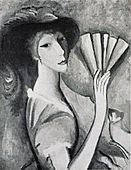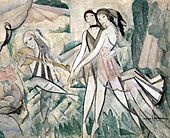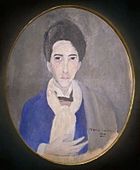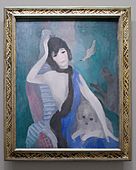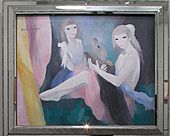Marie Laurencin facts for kids
Quick facts for kids
Marie Laurencin
|
|
|---|---|
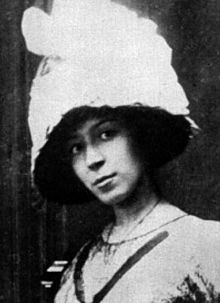
Marie Laurencin, c. 1912, Paris
|
|
| Born | 31 October 1883 Paris, France
|
| Died | 8 June 1956 (aged 72) Paris, France
|
| Known for | Painter |
| Movement | Cubism |
Marie Laurencin (born October 31, 1883 – died June 8, 1956) was a talented French artist. She was a painter and also made prints. Marie became a well-known person in the art world of Paris. She was part of the Cubist art movement, a group of artists who explored new ways of seeing and painting.
Contents
Marie Laurencin's Life Story
Marie Laurencin was born in Paris, France. She grew up there and lived most of her life in the city. When she was 18, she started studying how to paint on porcelain in a town called Sèvres. After that, she came back to Paris. She continued her art studies at the Académie Humbert. There, she decided to focus on oil painting.
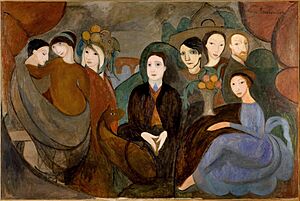
In the early 1900s, Marie was an important artist in Paris. She was part of the avant-garde art scene. This means she was among the artists who created new and experimental art. She was friends with famous artists like Pablo Picasso. She also joined the Cubists, a group that included Jean Metzinger and Albert Gleizes. Marie showed her art with them at big exhibitions. These included the Salon des Indépendants and the Salon d'Automne. She also showed her work at the first Cubist exhibition in Spain in 1912.
Marie was close to the poet Guillaume Apollinaire. Many people thought she was his inspiration. She also had connections to important social gatherings. These were hosted by the American writer Natalie Clifford Barney.
During the First World War, Marie had to leave France. She went to Spain with her husband, Baron Otto von Waëtjen. Because she married a German, she lost her French citizenship. The couple later lived for a short time in Düsseldorf, Germany. Marie missed Paris very much. Paris was the main center for art at that time. After she and her husband divorced in 1920, she returned to Paris. She became very successful as an artist. However, the economic problems of the 1930s made things harder. During the 1930s, she taught art at a private school. She lived in Paris until she passed away.
Marie Laurencin's Art Style
Marie Laurencin created many types of art. Her works include paintings, watercolors, drawings, and prints. She is known as one of the few female Cubist painters. Other female Cubists included Sonia Delaunay. While her art showed some influence from Cubist painters like Pablo Picasso, she developed her own unique style.
Marie often painted groups of women and animals. Her art was different from typical Cubist art. She used soft, pastel colors and flowing, curved shapes. This gave her work a special feminine look. At first, she was influenced by Fauvism, an art style known for bright colors. Then, the Cubists helped her simplify her shapes. From 1910, she mainly used colors like grey, pink, and other soft tones.
Her unique style became even clearer after she returned to Paris in the 1920s. The muted colors and geometric patterns from Cubism were replaced. Instead, she used light colors and wavy designs. Her signature style featured slender, dreamlike female figures. She used soft pastel colors to create a magical world in her art.
Marie continued to explore themes of femininity in her art until she died. Her works include paintings, watercolors, drawings, and prints.
- Selected works
-
1911, La Toilette des jeunes filles (Die Jungen Damen), a black and white photograph. This was shown at the 1913 Armory Show in New York.
Where to See Marie Laurencin's Art
Marie Laurencin's amazing art can be seen in collections all over the world. In 1983, a special museum opened in Nagano, Japan. It was called the Musée Marie Laurencin. This museum opened 100 years after she was born. It is the only museum in the world that only shows art by a female painter. The museum's founder, Masahiro Takano, loved Marie's beautiful and poetic art. The museum has over 600 of her artworks.
You can also find Marie Laurencin's work in other famous museums. These include The Museum of Modern Art in New York. Her art is also at the Hermitage Museum in St. Petersburg, Russia. The Tate Gallery in London, England, also has her work. In Paris, France, some of her most famous pieces are shown in the permanent collection of the Musée de l'Orangerie gallery.
See also
 In Spanish: Marie Laurencin para niños
In Spanish: Marie Laurencin para niños



